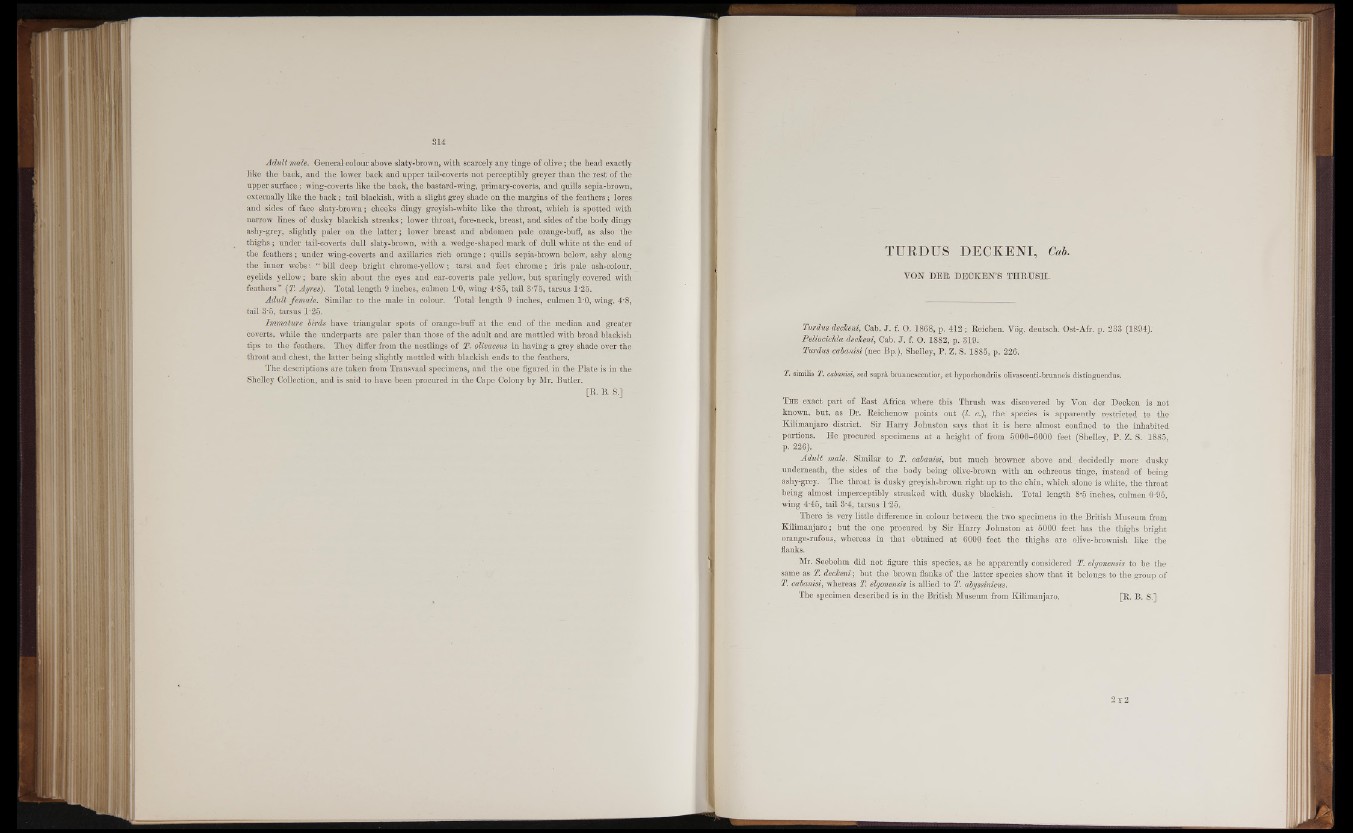
Adult male. General colour above slaty-brown, with scarcely any tinge of olive ; the head exactly
like the back, and the lower back and upper tail-coverts not perceptibly greyer than the rest of the
upper surface ; wing-coverts like the back, the bastard-wing, primary-coverts, and quills sepia-brown,
externally like the back ; tail blackish, with a slight grey shade on the margins of the feathers ; lores
and sides of face slaty-brown ; cheeks dingy greyish-white like the throat, which is spotted with
narrow lines of dusky blackish streaks ; lower throat, fore-neck, breast, and sides of the body dingy
ashy-grey, slightly paler on the latter ; lower breast and abdomen pale orange-buff, as also the
thighs ; under tail-coverts dull slaty-brown, with a wedge-shaped mark of dull white at the end of
the feathers ; under wing-coverts and axillaries rich orange ; quills sepia-brown below, ashy along
the inner webs : “ bill deep bright chrome-yellow ; tarsi and feet chrome ; iris pale ash-colour,
eyelids yellow ; bare skin about the eyes and ear-coverts pale yellow, but sparingly covered with
feathers” (T. Ayres). Total length 9 inches, culmen TO, wing 4*85, tail 3‘75, tarsus T25.
Adult female. Similar to the male in colour. Total length 9 inches, culmen 1*0, wing. 4*8,
tail 3-5, tarsus T25.
Immature birds have triangular spots of orange-buff at the end of the median and greater
coverts, while the underparts are paler than those of the adult and are mottled with broad blackish
tips to the feathers. They differ from the nestlings of T. olivaceus in having a grey shade over the
throat and chest, the latter being slightly mottled with blackish ends to the feathers.
The descriptions are taken from Transvaal specimens, and the one figured in the Plate is in the
Shelley Collection, and is said to have been procured in the Cape Colony by Mr. Butler.
[R. B. S.] -
TURDUS DEOKENI, Cab.
TON DER DECKEN’S THRUSH.
Turdus decJceni, Cab. J. f. O. 1868, p. 412 ; Reichen. Vog. deutsch. Ost-Afr. p. 233 (1894).
Peliocichla decJceni, Cab. J. f. O. 1882, p. 319.
Turdus cabanisi (nec Bp.), Shelley, P. Z. S. 1885, p. 226.
T. similis T. cabanisi, sed suprà brunnescentior, et hypochondriis olivascenti-brunneis distinguendus.
The exact part of East Africa where this Thrush was discovered by Yon der Decken is not
known, but, as Dr. Reichenow points out (I. c.), the species is apparently restricted to the
Kilimanjaro district. Sir Harry Johnston says that it is here almost confined to the inhabited
portions. He procured specimens at a height of from 5000-6000 feet (Shelley, P. Z. S. 1885,
p. 226). "
Adult male. Similar to T. cabanisi, but much browner above and. decidedly more dusky
underneath, the sides of the body being olive-brown with an ochreous tinge, instead of being
ashy-grey. The throat is dusky greyish-brown right up to the chin, which alone is white, the throat
being almost imperceptibly streaked with dusky blackish. Total length 8*5 inches, culmen 0-95,
wing 4*45, tail 3*4, tarsus T25. .
There is very little difference in colour between the two specimens in the British Museum from
Kilimanjaro; but the one procured by Sir Harry Johnston at 5000 feet has the thighs bright
orange-rufous, whereas in that obtained at 6000 feet the thighs are olive-brownish like the
flanks.
Mr. Seebohm did not figure this species, as he apparently considered T. elgonensis to be the
same as T. decJceni ; but the brown flanks of the latter species show that it belongs to the. group of
T. cabanisi, whereas T. elgonensis is allied to T. abyssinicus.
The specimen described is in the British Museum from Kilimanjaro. [R. B. S.]